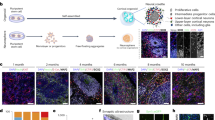In vitro and in vivo studies addressing the differentiation of neural stem and progenitor cells in the CNS require the use of highly specific markers for neurons and gliocytes. The aim of the present work was to study the distribution of a marker for differentiating neurons, i.e., doublecortin (DCX), in structures of the brain and spinal cord in rat embryos during the period preceding the formation of the cortical plate using immunocytochemical methods and light and confocal microscopy. DCX was detected in three types of cell in the developing nervous system at 13–14 days of embryogenesis: neurons giving reactions for the nuclear marker for differentiated nerve cells NeuN, migrating and differentiating neuroblasts, and some cells which are members of the population of radial gliocytes. The quite high selectivity of DCX expression allows use of this marker to be recommended for studies of the early stages of nervous system development in mammals.
Similar content being viewed by others
References
D. É. Korzhevskii, “The use of monoclonal antibodies to nuclear protein PCNA to detect proliferating cells in the developing human brain,” Morfologiya, 118, No. 5, 68–70 (2000).
D. É. Korzhevskii, E. G. Gilerovich, N. N. Zin’kova, et al., “Immunocytochemical detection of brain neurons using the selective marker NeuN,” Morfologiya, 28, No. 5, 76–78 (2005).
D. É. Korzhevskii, I. P. Grigor’ev, and V. A. Otellin, “Use of dehydrating fixers containing zinc salts in neurohistological studies,” Morfologiya, 129, No. 1, 85–86 (2006).
I. Bystron, P. Rakic, Z. Molnar, and C. Blakemore, “The first neurons of the human cerebral cortex,” Nat. Neurosci., 9, No. 7, 880–886 (2006).
J. G. Gleeson, “Classical lissencephaly and double cortex (sub-cortical band heterotopia): LIS1 and doublecortin,” Curr. Opin. Neurol., 13, No. 2, 121–125 (2000).
H. Koizumi, H. Higginbotham, T. Poon, et al., “Doublecortin maintains bipolar shape and nuclear translocation during migration in the adult forebrain,” Nat. Neurosci., 9, No. 6, 779–786 (2006).
R. C. Lin and D. F. Matesic, “Immunohistochemical demonstration of neuron-specific enolase and microtubule-associated protein 2 in reactive astrocytes after injury in the adult forebrain,” Neurosci., 60, No. 1, 11–16 (1994).
C. A. Moores, M. Perderiset, F. Francis, et al., “Mechanism of microtubule stabilization by doublecortin,” Mol. Cell, 14, No. 6, 833–839 (2004).
T. L. Walker, T. Yasuda, D. J. Adams, and P. J. Bartlett, “The doublecortin-expressing population in the developing and adult brain contains multipotential precursors in addition to neuronal-lineage cells,” J. Neurosci., 27, No. 14, 3734–3742 (2007).
Author information
Authors and Affiliations
Additional information
Translated from Morfologiya, Vol. 133, No. 4, pp. 7–10, July–August, 2008.
Rights and permissions
About this article
Cite this article
Korzhevskii, D.É., Petrova, E.S., Kirik, O.V. et al. Assessment of neuron differentiation during embryogenesis in rats using immunocytochemical detection of doublecortin. Neurosci Behav Physi 39, 513–516 (2009). https://doi.org/10.1007/s11055-009-9164-0
Received:
Published:
Issue Date:
DOI: https://doi.org/10.1007/s11055-009-9164-0




